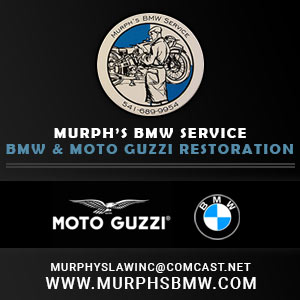brake bleeding help
i have a 1978 R100/7 single 40mm ATE caliper. i am having lots of fun bleeding the system. i installed new caliper seals and piston. i have read all the airmail postings and have followed Tom Cutter's instructions on bleeding and adjusting the eccentric caliper pin. i have now gone from no brakes to somewhat firmer brakes. Checking the new forum to see if there are any other ideas to try. I even used the back bleeding system using a bottle hung over the master cylinder and back bleed through the caliper. the master was rebuilt a couple of years ago but did not touch the caliper. i had great breaks before the caliper rebuild but just wanted to have the caliper in great shape.
thanks
joe
Your description is not very clear to me. If by "back bleeding" you mean forcing fluid into the caliper bleed nipple and all the way up to the master cylinder (m/c), then that is the better method. This method assumes you have first thoroughly cleaned the bleed nipple holes and blown everything out with compressed air. Otherwise trash that was in the nipple is now inside your brake system. It also is best if the fluid source is located above the caliper and connected with a clear hose. When you use this method, all the air is forced out at the reservoir and no more traditional "bleeding" should be needed.
► During any brake fluid bleeding attempt, the m/c self bleed hole must be the highest point in the system. If this is "true", then the system will tend to be self-bleeding since air will flow to the highest point in the system, namely the reservoir. IME this leaves 2 areas you could get into trouble:
• The flexible line(s) coming off the top of the fork leg(s) sometimes dip downward before they enter the fixed mounting on the frame. You'll need to push the line to the side to take out the slack and give a constant upward path for any air bubbles.
• The m/c itself is attached to the top frame tube and therefore canted backwards and becomes self defeating. Loosen the band clamp and wedge a rag under the actuator end (the rear) so that air is not trapped in the higher, front end of the m/c.
► Of course, any pumping of the lever should be slow and easy. Fast lever pumping, or "back bleeding" with a hand pump, may inject more air than you remove.
► Air bubbles may also get hung on the pipe unions. Gently tap the hose/pipe unions with the plastic handle of a screwdriver to help encourage these laggards to move along.
Hope this helps.
Owning an old Airhead is easy.
Keeping an old Airhead running great is the true test.
I had good luck with the vacuum bleeder kit from Harbor Freight. After rebuilding the master I could not get it to push the air out the bleed valve, tried for at least an hour and just would not do it. So then I got the vac kit from HF and it worked like a charm. It's worth the $25 in my experience, the quality of the parts is acceptable, and the kit has a number of different fittings for different uses.
Carl
Carl
- 27 Forums
- 1,908 Topics
- 10.9 K Posts
- 5 Online
- 5,958 Members





